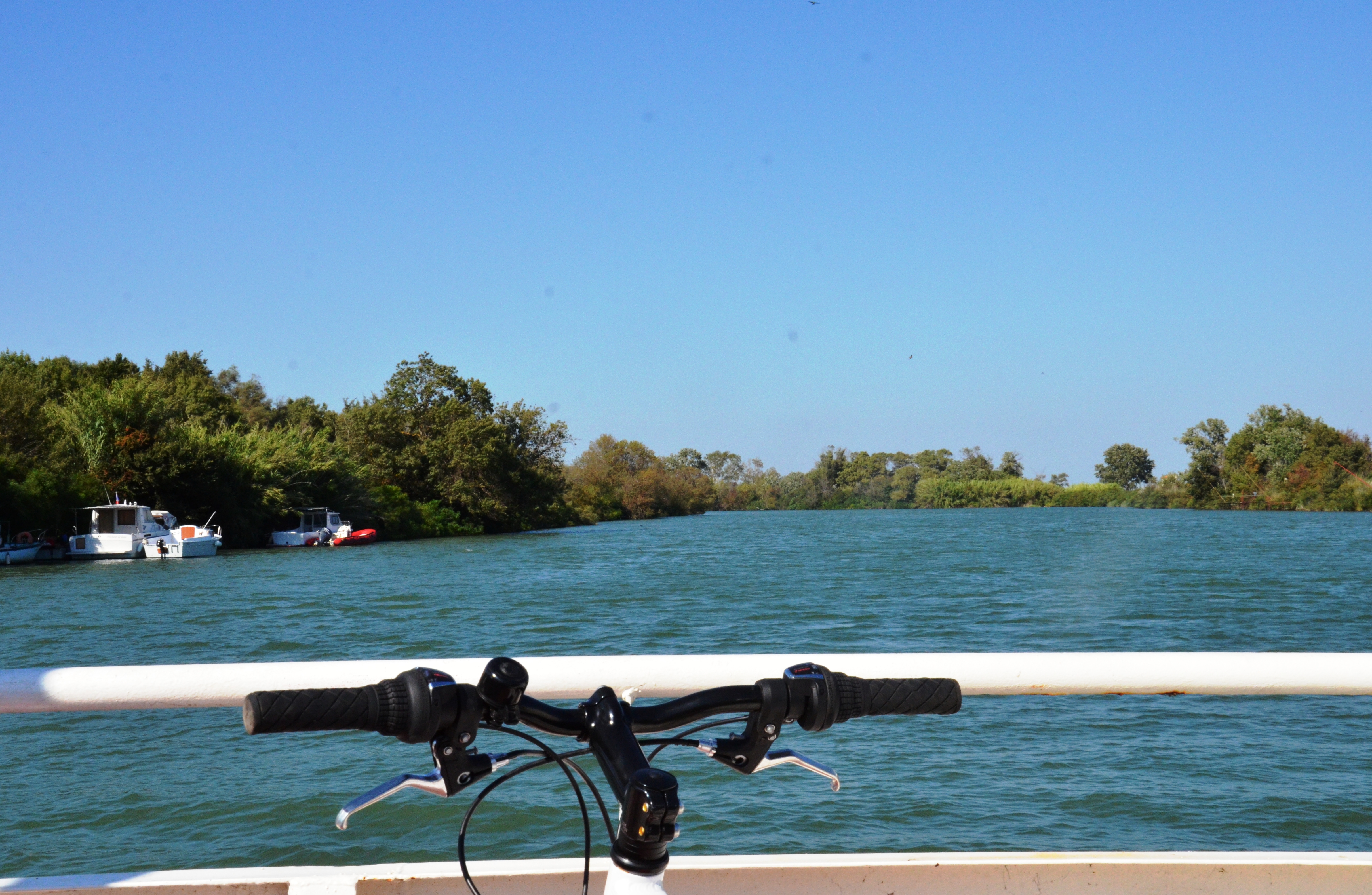
“Astouin” cycling circuit
17 points of interest

Mas de l'Amarée - ©Juliette Primpier - PNR Camargue  Patrimony and history
Patrimony and historyThe Amarée Mas
The Amarée Mas was rented in 1899 by the Baroncelli marquis, writer and manadier who developed the Camargue, he exploited the traditions of the territory such as the Camargue race and the Gypsy pilgrimage. The Amarée mas which extends over 200 ha, the main house adjoins a stable Due to financial problems, Baroncelli is forced to leave the Amarée, the Saintois contribute to offer him the land of Simbèu mas where he builds a farmhouse similar to the one of Amarée.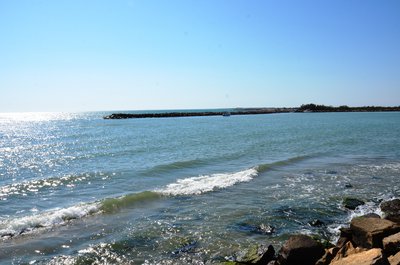
Embouchure du Petit-Rhône - ©Juliette Primpier - PNR Camargue  Water and rivers
Water and riversThe Petit-Rhône estuary
The Petit-Rhône is one of the two arms of the Rhone Delta that leaves the main riverbed north of Arles to jump into the Mediterranean Sea. The Petit-Rhône estuary is located 2 km west of Saintes-Maries-de-la-Mer and is called Grau d'Orgon. The Clos du Rhône beach, located at the Petit Rhône estuary, is the last beach of Saintes-Maries-de-la-Mer. On the other side of the Petit-Rhône, there is the Espiguette Port Camargue beach.
Cabane de gardian - ©Juliette Primpier - PNR Camargue  Patrimony and history
Patrimony and historyThe Gardian Hut
Traditional home of guardians of Camargue, the hut has whitewashed walls and a roof of sagne (reeds marshes). The architecture of these cabins is original : straight walls on all sides except the one exposed to the mistral (north-west) which is in apse (of rounded form) to offer less catch in the wind. At the top of this apse, there is usually a form of cross or horn that used to stow the cabin on the ground during windy days.
Croix de Camargue - ©Juliette Primpier - PNR Camargue  Patrimony and history
Patrimony and historyThe Camargue Cross
The painter and sculptor Hermann Paul conceives the Camargue Cross in 1926 following the request of Marquis Baroncelli, « inventor » of the Camargue. It associates the guardians and the fishermen and symbolizes three virtues: the Cross for Faith, the Anchor for Hope and the Heart for Charity. The guardians and the Camargue soul are represented by the tridents. The original cross was made in wrought iron by Joseph Barbanson and inaugurated on July 7, 1926.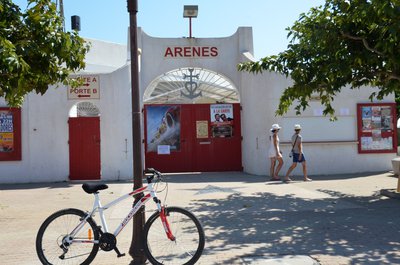
Arènes des Saintes-Maries-de-la-Mer - ©Juliette Primpier - PNR Camargue  Patrimony and history
Patrimony and historyThe arenas of Saintes-Maries-de-la-Mer
The arenas of Saintes-Maries-de-la-Mer were inaugurated in 1931 and can accommodate 4,500 people. They are built in hard material and have a circular shape.. Part of the arena collapsed in 1931, and was rebuilt in 1932. In 1985, they were redesigned by the architect André Marchetti. They offer three forms of bull races: the Camargue race, the Spanish race, and the rejón bullfight where the bull is fought by a rider, the rejoneador.
Course camarguaise - ©Marjorie Mercier - PNR Camargue  Elevage et pastoralisme
Elevage et pastoralismeThe Camarguaise Race
Originally, the race is a taurine game where animals and farmhands fight and play with the bull. Towards the end of the 19th century, this bullfighting game becomes less violent and only the man plays with the bull. We fix the attributes on the horns of the Camargue bull intended to be removed by the raseteurs dressed in white, now only protagonists of the race. A cockade is fixed on the horns of the bull and bonuses are awarded to the one who will pick up the attribute.
Port Gardian - ©Juliette Primpier - PNR Camargue  Water and rivers
Water and riversThe Port Gardian
The creation of the marina, Port Gardian, dates back to the development of tourism in the Camargue in the mid-twentieth century. Built in June 1984, it has managed to keep its family atmosphere and its human dimension. This harbour has 380 rings. The village church, located not far from the port, 200 m from the wharves, is used as bitter, a landmark fixed and unambiguously identifiable. It guides boaters and fishermen sailing on the Mediterranean Sea.
Cavaliers empruntant le bac du Sauvage - ©DR  Water and rivers
Water and riversSauvage’s ferry
Put in circulation in 1972, Sauvage4s ferry was completely renovated in 2004. It allows to connect the two banks of the Petit-Rhône for free It is powered by two side impellers with no possibility of steering and its circulation is facilitated by a cable. The ferry can carry 8 cars, 30 passengers and the crew for a crossing of a duration of 2 min. The nearby equestrian centres offer ballads for which you have to take the ferry, so it is common to see horses on board.

Pont de Sylvéréal dans la Réserve de biosphère de Camargue - ©Opus Species - PNR Camargue  Flora
FloraThe Camargue Biosphere Reserve
The Camargue was classified as a Biosphere Reserve in 1977. Between these folds still partly wooded, you will find low lands occupied by lagoons lined with salt steppes, reed marshes and ponds. The agricultural lands are composed of wet meadows and grazers dedicated to the grazing of bulls and horses, old marshes converted into rice paddies of lagoons designed for the exploitation of salt and vegetable crops and viticulture on the dunes.
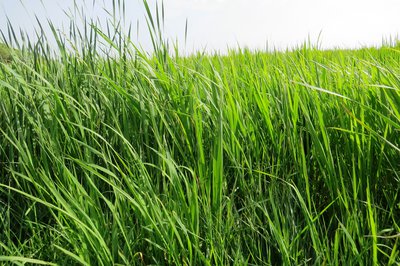
Rizière - ©Laurie Vannel - PNR Camargue  Produits du terroir
Produits du terroirRice fields
Rice farming has been present in the Camargue since the post-war period. Complex, this culture follows several stages: lifting, tillering, bolting, return and flowering. The land is flooded to promote the germination of rice grains and prevent the proliferation of fungi. Rice farming therefore requires freshwater irrigation and extensive drainage to develop the saltiest land. Huge amounts of water between the two arms of the Rhône (400 million m3 per year) are needed.
Domaine du château d'Astouin - ©Opus Species - PNR Camargue  Patrimony and history
Patrimony and historyThe Astouin castle estate
The Astouin castle estate was able to develop itself hanks to the containment of the Rhone, close to agricultural activities, between Petit-Rhône and the Vaccarès pond. The Astouin castle estate consists of a farmhouse dating from the eighteenth century, an old chapel and a large park and is surrounded by rice paddies. It is at the foot of the cross located in the Astouin castle estate that the Crusaders in the 11th century. would have gathered before embarking for the Holy Land.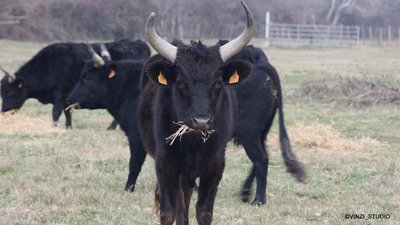
Taureaux de Camargue - ©Vinzi Studio  Elevage et pastoralisme
Elevage et pastoralismeThe bull of Camargue
The bull of Camargue, also called bull of Raço di Bioù (in Provençal), is slender and fiery. The Camargue bull is a French bovine breed. It sports beautiful horns shaped lyres. Its breeding is mainly intended for the Camargue race, also called race "with the cockade". It can also be admired during ferrades, during which the anouble, a young bull of one year, is separated from the herd to be affixed a fire brand.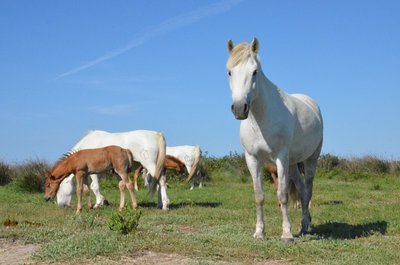
Chevaux de Camargue - ©Marjorie Mercier - PNR Camargue  Elevage et pastoralisme
Elevage et pastoralismeThe Horses of the Camargue
The Camargue horse is a very old breed (1978) and would descend from the prehistoric horse of Solutré. Symbol of the Camargue, with a gray-white dress, short ears and a shaggy mane, it is small, about 1.45 m at the withers. His dark hair of birth takes its final colour white-gray when he is around 4 years old. Raised in the Camargue, he is the companion of the guardian and the working tool for raising bulls. Breeding and reproduction criteria are strict to preserve his breed.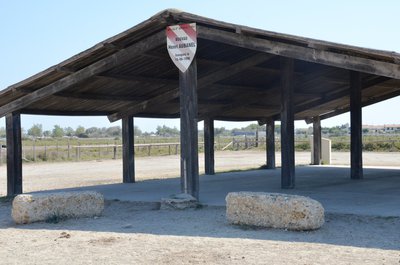
Manade Aubanel Baroncelli Santenco - ©Juliette Primpier - PNR Camargue  Patrimony and history
Patrimony and historyLe Bouvau d’Aubanel
The Baroncelli marquis, famous character of Camargue life, gave to his manade the name of Manade Santenco which means, in Provençal, manade of Saintes-Maries. At the death of the marquis, his son-in-law Henri Aubanel then manages the Santenco manade.. On June 15, 1996, the Saintes-Maries-de-la-Mer inaugurate the Henri Aubanel bouvau, a circular enclosure where bulls are grouped after selection. At the death of Henri Aubanel, his son Pierre manages the manade that he renames Aubanel Baroncelli Santenco manade.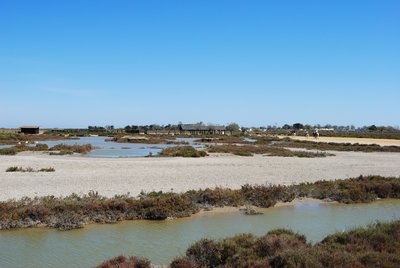
Le long de la draille de Méjanes - ©Chloé Scannapiéco - PNR Camargue  Panorama
PanoramaThe Departmental Reserve of Imperialists
Classified Departmental Reserve, Imperial and Malagroy Ponds were acquired by the Departmental Council of Bouches-du-Rhone in 1964 to protect these fragile natural environments (2,770 ha) which are home to many species of birds. The fishing, a traditional activity in Camargue, is practiced in the Imperial reserve in a boat without motor which imposes the use, as formerly, of the "partygue" (pole). Fishermen are looking for shrimps, eels.

Anguille sortie du filet - ©Julien Faure - PNR Camargue  Fauna
FaunaThe eel
At the graus level (or passages), communication canals between the sea and the littoral ponds, you will find fish, towards the flooded sansouïre and the ponds or towards the sea. Migrating species include mullet, sea bass, but also sea bream, sole and especially eel. Born in the Sargasso Sea, she joined the Atlantic and Mediterranean coasts after a long journey. She comes to grow in the coastal ponds or rivers where she spends several years of her life.
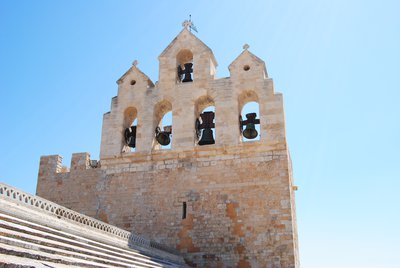
Les cloches de l'église - ©Chloé Scannapiéco - PNR Camargue  Panorama
PanoramaThe fortified church of Saintes-Maries-de-la-Mer
True highlight of the Camargue (15 m), the church offers a breathtaking view of the village and all the Camargue. The 53 steps of a spiral staircase lead to the roof of the church where the panorama unfolds in all its splendour : up there, you can take advantage of a wide angle vision on the city, the sea and the ponds. Intense and sparkling blue of the Mediterranean Sea, purple hue of the Imperial pond The wind, the sun, the view of the calm expanse of the sea invite you to discover this landscape.
Description
1 - Turn left on the D85 and take the Sauvage ferry (information about ferry times at the Tourist Office). Continue on the D85 towards Aigues-Mortes and cross the small bridge that spans the Peccais Canal at Sylvéréal.
2 - At the intersection of the D58, turn right and continue for 350 m towards Arles. Take the bridge over the Petit-Rhône.
3- Then turn right towards S33. Walk 2 km and reach the Astouin hamlet. Leave on the left the Astouin Castle estate.
4 - At the intersection with the D38, go to the right and continue the D38 for more than 3,5 km.
5 - Take the D38A, turn left and continue straight until you reach the D570.
6- At the intersection with the D570, turn right and continue for about 4.5 km.
7 - After the Le Boumian hotel, take the small dirt road on the left, parallel to the D570. Continue straight for about 1.5 km.
8 - Turn left before the roubine (stream). Continue the path that runs along the roubine. Pass the small bridge and continue to the right. Continue straight and turn right on the road to Cacharel and cross the village to regain the starting point of the circuit, the Tourist Office of Saintes-Maries-de-la-Mer.
- Departure : Tourist Office, les Saintes-Maries-de-la-Mer
- Arrival : Les Saintes-Maries-de-la-Mer
- Towns crossed : Saintes-Maries-de-la-Mer and Vauvert
Forecast
Altimetric profile
Recommandations
D58 up to Sylvéréal, dangerous road!
Stay alert on the D570, busy road.
Respect the rules of the road on roads open to public traffic.
Information desks
the Camargue museum
Mas du pont de rousty, 13200 Arles
Remember to visit the Camargue museum! It is located next to the administrative centre of the Camargue Nature Park.
OT Saintes-Maries-de-la-Mer - Tourisme en Camargue
5 Avenue Van Gogh, 13460 Saintes Maries de la Mer
Transport
Access and parking
Parking :
Access
- Emergency number :
- 114
Report a problem or an error
If you have found an error on this page or if you have noticed any problems during your hike, please report them to us here:


